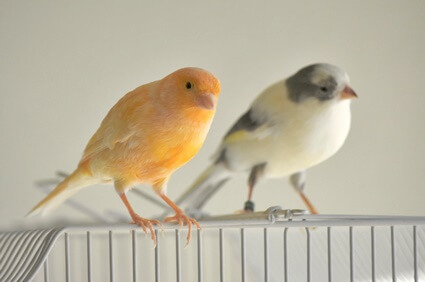While socialization is vital for humans, the same isn’t so for canaries. Unlike most birds, canaries dislike company and are unlikely to make friends with a second canary.
Canaries are primarily solitary birds, only coming together to mate, raise their young, and forage in small groups. If a canary has space, toys, and food, it’ll be happy alone.
A pair of female canaries is preferred when keeping two canaries together.
Avoid pairing two male canaries as they’ll fight and could injure each other. Males and females sometimes get along, but they only pair up to breed and care for their chicks.
Do Canaries Live in Pairs?
Wild canaries don’t live in pairs, spending most of their days flying and foraging alone or in small groups. Though canary flocks exist, they aren’t as flock-dependent as other birds.
In the spring, solitary male canaries seek out female canaries to mate. Male canaries stay with the female while she lays eggs and cares for their young.
The young hatchlings, especially the males, learn their first songs from their fathers. Once the hatchlings are old enough, the mother and father separate.
Do Canaries Get Lonely?
Canaries don’t get lonely unless they’re neglected.
Part of the reason canaries are popular pets is that they can be left alone most of the day. They’re good at entertaining themselves when given enough space and toys.
If you have a male canary, you may notice it sings a lot, especially during spring. That’s because spring is the breeding season, so your bird is calling for a partner.
This may sound sad, as it may lead you to believe the canary is lonely. However, canaries are only driven to call out for a mate out of instinct.
Male canaries are also bred to sing a lot. So, never interpret your canary’s hours of serenading to mean it hates being the only bird in the house.

Should You Keep Canaries in Pairs?
If you want a new canary because you want the original canary to have company, you should rethink the idea. Canaries don’t feel lonely if they’re cared for properly.
Some canaries are neophobic, which means they fear new experiences. Introducing a second canary can stress out the first canary.
Many canary enthusiasts believe that you should get another canary if the first one doesn’t sing. The second canary could teach the original canary to sing.
However, getting a new canary doesn’t always solve this problem. If your silent canary is female, she won’t sing because female canaries are less capable of singing than males.
The European Journal of Neuroscience found that male canaries sing less when paired with females. They no longer need to call for a mate if a potential mate is nearby.
Can You Have Two Male Canaries Together?
If you want to care for two male canaries, you must keep them apart.
Canaries are very jealous and territorial birds, especially males. They fight a lot, so there’s always a chance they’ll injure each other if paired.
Two males should be kept apart in different cages. If you can, keep them separate enough that they can’t even look at each other. If they can, they’ll threaten each other non-stop by singing.
You shouldn’t pair two males if you want two canaries that sing a lot.
Male canaries see each other as threats, not friends or family. You’ll make the environment hostile for both birds by pairing two males together.
In the wild, two opposing birds can eventually end their conflict—one takes the territory, and the other runs off to find its own space.
However, that isn’t an option for two males in captivity. Each bird will be under constant stress, believing the other male will take its territory and resources.
Can You Keep Two Female Canaries Together?
Two female canaries can usually live harmoniously together. Female canaries have no reason to fight unless resources are scarce. Aside from food and water, canaries need a lot of space.
You’ll need to upgrade two females to a large cage to house them together. If both canaries feel like they don’t have enough space to fly around, they’ll get territorial and fight.
If you can’t get a big cage, get two small or medium-sized ones and keep them side-by-side.
Before getting another female, you must consider your current canary’s temperament. Some female canaries are naturally combative, and your canary might not like having a cage companion, so you must closely watch both birds to ensure they don’t fight.
Wild canaries lay eggs in late spring through to mid-summer. Depending on your climate and the conditions you keep your canaries in, your canary might lay eggs at a different time.
Female canaries lay unfertilized eggs regardless of whether there was a male involved. When they do, the stress of nesting and egg-laying makes females territorial and aggressive.
If you know when your female canaries lay eggs, keep them separate during the process. Check for nesting behavior if you don’t know when it’ll happen.
You can discourage female nesting behavior through temperature changes and exposure to sunlight.
Can Male and Female Canaries Live Together?
Male and female canaries should be kept apart unless you want them to breed. Male and female canaries often bully each other in the same cage.
This doesn’t mean the male and female will be at each other’s throats. There may be times when both canaries can get along well, usually in the summer.
At this time, canaries molt. This process takes time and energy, so canaries will be docile while molting. However, it’s also a stressful time because they’re vulnerable during their molt, and having a cage companion may be a source of stress.
A male and female may be docile enough to share a space. As long as they have their own space in a big cage, they can share common areas, such as a feeding and bathing area.
Even if your male and female bully each other, you can pair them together during the breeding season. They’ll cooperate long enough to mate and raise their young.

How To Help A Pair of Canaries Get Along
If you want your two canaries to get along, here are steps you can take:
Slow Introduction
It’s hard to tell how canaries will behave towards each other at first.
So, introduce them slowly to make it easier to spot red flags in their behavior. Keep an eye on them during the initial interactions so that you can separate them if a fight occurs.
Larger Cage
A bigger cage will make your canaries feel like they don’t have to fight for personal space. That way, they’ll be more likely to get along.
Separate Toys
Some canaries are jealous of their possessions. If one canary thinks the other stole its toys, a fight will break out, so keep the toys in separate parts of the house or cage.
Know When To Separate Them
Pay attention to the way your canaries treat each other.
Their hormones and behavior change depending on the season, so they may not always get along. Every time the canaries need to molt, lay eggs, prepare a nest, or breed, monitor them closely.
Feed Them Together
Feeding canaries together will help them feel like there’s enough food to go around, as it’ll prevent food aggression and keep them from getting stressed about resources.
More Perches
Canaries are territorial in the presence of other birds, so ensure that each canary has its perch. Even if the perch in the cage is sufficiently large, some canaries may not want to share.
Usually, it’s best to have a lone canary. However, with the proper preparation, you may be able to pair two female canaries. Never pair two males or a male and female unless you’re breeding them.







